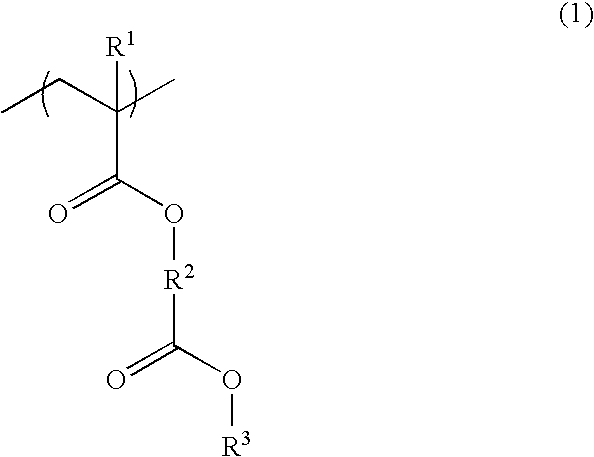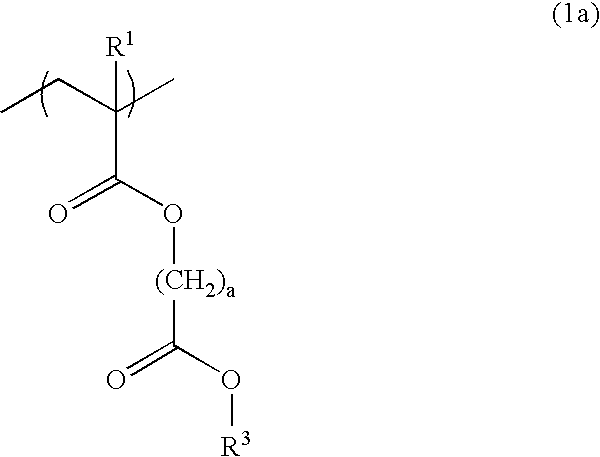Polymer, resist composition and patterning process
a composition and resist technology, applied in the field of resist compositions, can solve the problems of unsolved arf resist materials, reduced line edge roughness, and postponement of fsub>2 /sub>laser use, so as to improve etch resistance, improve resolution, and reduce the effect of line edge roughness
- Summary
- Abstract
- Description
- Claims
- Application Information
AI Technical Summary
Benefits of technology
Problems solved by technology
Method used
Image
Examples
polymer synthesis example 2
Copolymerization of Monomers 1, 2 and 4 (45 / 25 / 30)
[0164]A 100-mL flask was charged with 7.05 g of Monomer 1, 4.47 g of Monomer 2, 8.47 g of Monomer 4, and 5.0 g of toluene. The system was purged of oxygen, after which 0.30 g of AIBN was added to the mixture in a nitrogen atmosphere. The contents were stirred at 60° C. for 24 hours. The reaction mixture was cooled down to room temperature and admitted into 400 g of n-hexane whereupon a polymer precipitated. The polymer was washed with n-hexane, isolated and dried in vacuo at 40° C. for 20 hours. There was obtained 14.9 g of a white polymer, designated Polymer 2, which had a Mw of 8,400 and a dispersity (Mw / Mn) of 1.5 as determined by GPC. From an integration ratio of its 1H-NMR spectrum, Polymer 2 was found to have a copolymer composition ratio (molar ratio) of 45.4:24.7:29.9.
[0165]Monomer 4 is shown below.
[0166]
polymer synthesis example 3
Copolymerization of Monomers 5, 6, 2 and 3 (45 / 10 / 15 / 30)
[0167]A 100-mL flask was charged with 8.44 g of Monomer 5, 3.53 g of Monomer 6, 2.78 g of Monomer 2, 5.25 g of Monomer 3, and 5.0 g of toluene. The system was purged of oxygen, after which 0.31 g of AIBN was added to the mixture in a nitrogen atmosphere. The contents were stirred at 60° C. for 24 hours. The reaction mixture was cooled down to room temperature and admitted into 400 g of n-hexane whereupon a polymer precipitated. The polymer was washed with n-hexane, isolated and dried in vacuo at 40° C. for 20 hours. There was obtained 13.9 g of a white polymer, designated Polymer 3, which had a Mw of 8,100 and a dispersity (Mw / Mn) of 1.5 as determined by GPC. From an integration ratio of its 1H-NMR spectrum, Polymer 3 was found to have a copolymer composition ratio (molar ratio) of 44.9:10.1:15.1:29.9.
[0168]Monomers 5 and 6 are shown below.
[0169]
polymer synthesis example 4
Copolymerization of Monomers 7, 6, 2 and 3 (45 / 10 / 15 / 30)
[0170]A 100-mL flask was charged with 9.25 g of Monomer 7, 3.29 g of Monomer 6, 2.58 g of Monomer 2, 4.88 g of Monomer 3, and 5.0 g of toluene. The system was purged of oxygen, after which 0.29 g of AIBN was added to the mixture in a nitrogen atmosphere. The contents were stirred at 60° C. for 24 hours. The reaction mixture was cooled down to room temperature and admitted into 400 g of n-hexane whereupon a polymer precipitated. The polymer was washed with n-hexane, isolated and dried in vacuo at 40° C. for 20 hours. There was obtained 14.2 g of a white polymer, designated Polymer 4, which had a Mw of 8,000 and a dispersity (Mw / Mn) of 1.5 as determined by GPC. From an integration ratio of its 1H-NMR spectrum, Polymer 4 was found to have a copolymer composition ratio (molar ratio) of 44.6:10.1:15.4:29.9.
[0171]Monomer 7 is shown below.
[0172]
PUM
| Property | Measurement | Unit |
|---|---|---|
| size | aaaaa | aaaaa |
| size | aaaaa | aaaaa |
| refractive index | aaaaa | aaaaa |
Abstract
Description
Claims
Application Information
 Login to View More
Login to View More - R&D
- Intellectual Property
- Life Sciences
- Materials
- Tech Scout
- Unparalleled Data Quality
- Higher Quality Content
- 60% Fewer Hallucinations
Browse by: Latest US Patents, China's latest patents, Technical Efficacy Thesaurus, Application Domain, Technology Topic, Popular Technical Reports.
© 2025 PatSnap. All rights reserved.Legal|Privacy policy|Modern Slavery Act Transparency Statement|Sitemap|About US| Contact US: help@patsnap.com



